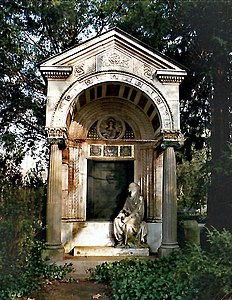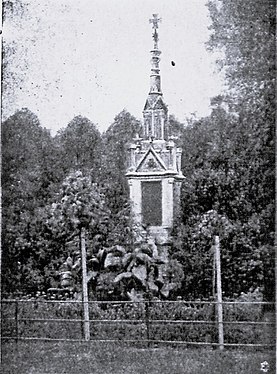Burgtorfriedhof
Today's Burgtorfriedhof , originally General Gottesacker , is the successor to other cemeteries in the Lübeck suburb of St. Gertrud . It was officially opened in 1834 and today covers an area of around eight hectares and around 8,700 graves.
history
When Lübeck was struck by the plague in 1350, a cemetery had to be built outside the city walls for the numerous victims. This plague cemetery was first mentioned in 1373. A small chapel was added later, named after the patron saint of travelers (St. Gertrud; eponymous for the later part of the city). The exact location of this cemetery is currently not available.
This burial place was evidently moved to the northwest corner of the castle field after the chapel was demolished (1622) . Here, where the youth hostel stands today, the street name Am Gertrudenkirchhof still reminds of that time. It is also documented that no further graves were created at this new location after 1867. This cemetery complex was also called Armesünderkirchhof , as those executed from the place of execution on the other side of the street ( Israelsdorfer Allee / corner of Adolfstraße) found their final resting place here.
On August 2, 1828, the Senate decided to set up a new general churchyard in front of the castle gate . After initial resistance, under the impression of a cholera epidemic in 1832, the new cemetery at Sandberg was laid out as planned from 1832 and inaugurated on July 19, 1832. The churchyard, initially 7.6 hectares in size, was initially divided into the districts (= quarters) of the Lübeck main churches St. Jakobi , St. Petri , St. Marien , Dom and St. Aegidien , which jointly owned the cemetery.
The cemetery chapel was built in 1869 and the morgue in 1892. In 1902 the new section was extended to the north behind the morgue, increasing the total area to eight hectares. In 1907 the city of Lübeck took over the sponsorship of the entire facility. The erection of mausoleums required the approval of the Senate. Today the cemetery has around 8,700 graves.
Notable resting places
Prominent people from culture, business and politics found their final resting place there. 28 members of the Mann family alone were buried here. At the cemetery were 13 honorary graves and four war graves permanently maintained by the city. As the 14th honorary grave, the grave of the politician Adolf Ehrtmann (1897–1979) was added in 2018 at the request of the “ecumenical working group 10 November Lübeck Martyrs” .
Historic burial sites
- Henning von Arnim (1916–1990), Chief Finance President (family grave)
- Ida Boy-Ed (1852–1928), writer
- Johann Daniel Eschenburg (1809–1884), businessman and politician
- Emanuel Geibel (1815–1884), poet
- Willy (Wilhelm) Glogner (1869–1968), architect (family grave)
- Carl von Großheim (1841–1911), architect (family grave)
- Georg Kalkbrenner (1875–1956), recipient of the Great Federal Cross of Merit (honorary grave)
- Karl Peter Klügmann (1835–1915), Hanseatic envoy to the Prussian court
- Lothar Malskat (1913–1988), painter and art forger
- Thomas Johann Heinrich Mann (1840–1891), Senator, father of Heinrich and Thomas Mann
- Emil Minlos (1828–1901), merchant, royal Prussian consul in Maracaibo and social reformer
- Peter Rehder (1843–1920), senior construction director, who laid out waterways and green spaces
- The Türk family, with Emmy Eschricht and Titus Türk
Forgotten tombs:
- Friedrich Krüger (1819–1896), Hanseatic envoy to the Prussian court
- Special tombs
Schultze family grave. Christ statue by Lambert Piedboeuf
The personalities born in Lübeck who found their final resting place in the cemetery include the entrepreneur and patron Emil Possehl , whose mausoleum was designed by the architect Erich Blunck and the sculptor Hermann Joachim Pagels , the businessman Emil Minlos and the actor Günther Lüders (1905– 1975).
Karl Boy-Ed (1872–1930), largely unknown in Germany, is almost within sight of his mother's grave. During the First World War he was active as a spy and saboteur in the United States, where he achieved negative fame as the notorious German Captain . Boy-Ed died on his 58th birthday after a riding accident.
The hit man Werner Pinzner (1947–1986), known as "Mucki" , was also buried in the cemetery.
Dissolved graves
- Walther Brecht (1841–1909), under him the upward movement of the LBE took place
- August Eschenburg (1848–1910), Prussian officer, most recently major general
- Marianne Bachmeier (1950–1996) practiced vigilante justice on the alleged murderer of her daughter
- Paul Hoff (1867–1928), committed suicide as a senator
- Wilhelm von Kettler (1846–1928), first commander of the Lübeck infantry regiment, lieutenant general, commander in China
- Henry Koch (1832–1888), revolutionized shipbuilding in Lübeck (1997)
- Ludwig Wilhelm Minlos (1826–1895), businessman and Senator from Lübeck
- Christian Reuter (1863–1915), historian and educator
- Adolf von Tiedemann (1865–1915), officer, colonialist, publicist
War memorials
Community graves were created in the Burgtorfriedhof for the German and French soldiers who died in Lübeck hospitals during and after the Franco-German War .
The grave of the German soldiers was adorned with a tall, richly decorated sandstone monument, the tower-like structure of which is crowned by an iron cross . The dead listed on the back of the memorial came from the "Garrison-Lazareth des Mecklb.-Schwerin. Gren.-Reg. No. 89 , 1st bat. "
A few steps from the German communal grave is that of the French soldiers who died here, in the form of a granite boulder that was then overgrown by ivy. Its inscription indicates that the soldiers who died in the reserve hospital in Lübeck are resting there.
Lübeck itself does not have a large public monument to its fallen soldiers, mostly fusiliers from the local battalion of the 2nd Hanseatic Infantry Regiment No. 76 , from that war. These are listed on handsome panels behind the altar of St. Mary's Church .
- War graves in the Burgtorfriedhof
Since 1896, the 25th anniversary of the Battle of Sedan , which sparked Sedan Day in Lübeck October 18, the day of the Battle of Leipzig , as a warrior memorial from. Since the Hanseatic city did not have a public war memorial for the fallen from the Franco-German War, the ceremony took place at the war graves in the Burgtorfriedhof. After a service on the morning of the feast day, people went to the “general churchyard” with funeral music in order to decorate the war graves, which were initially free on the path that cut the length of the churchyard. The main part of the celebration was the commemorative speech and quartet singing of the united song tables. This ceremony took place for the last time in 1914.
For the victims of the First and later the Second World War , the cemetery of honor was laid out on the other side of the Sandberg in January 1915 and then expanded several times.
See also
literature
- Lübeck cemeteries: Burgtorfriedhof. Information brochure 2002
Web links
- Search for Burgtorfriedhof in the German Digital Library
- Search for Burgtorfriedhof in the SPK digital portal of the Prussian Cultural Heritage Foundation
- current plan with honorary funerals
Individual evidence
- ↑ Was renamed Travemünder Allee during the Third Reich and was the only one of the streets renamed at that time to keep its name after the Second World War .
- ↑ As of March 2013, see the brochure Hanseatic City of Lübeck: Der Friedhofswegweiser. 2nd edition 2013, p. 39
- ↑ As of March 2013, see the brochure Hanseatic City of Lübeck: Der Friedhofswegweiser. 2nd edition 2013, p. 41
- ↑ Honorary grave for Adolf Ehrtmann. In: Lübecker Nachrichten . March 8, 2018, p. 13.
- ↑ Schleswig-Holstein Chamber of Agriculture (ed.): Garden routes between the seas. Route 5: Lübeck. 2nd revised edition, Kiel, May 2010
- ↑ Pompous tombs and modest tombs . In: Lübecker Stadtzeitung from April 6, 1999.
- ↑ The war graves in the general church field. In: Vaterstädtische Blätter , year 1903, No. 37, edition of September 13, 1903, pp. 289–291.
Coordinates: 53 ° 53 ′ 5 " N , 10 ° 42 ′ 17" E










